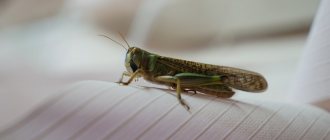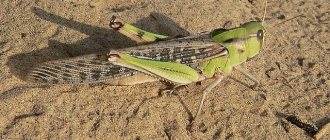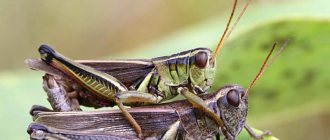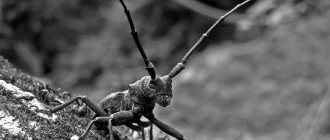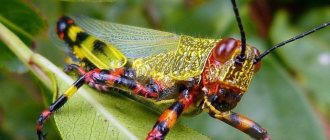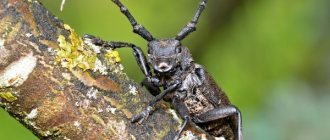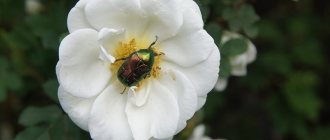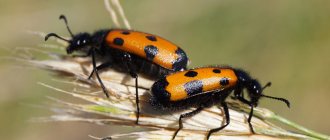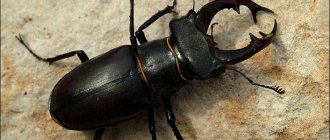The fight against locusts has been going on for many centuries. Insects have an excellent appetite and eat ornamental and cultivated plants. The greatest threat to agricultural land is posed by swarms of locusts, which can destroy an entire field in a matter of hours. In Rus', during the period of invasions, all residents of the provinces went out to fight insects. Armed with rattles, pots and anything that made loud sounds, they drove the flyers away from the fields, preventing them from landing on the ground.
Interesting! A. Pushkin had a chance to witness one of the locust migrations, about which he wrote a short report: “May 23 – flew, 24 – landed, 25 – ate everything, 26 flew away.”
Modern control measures have undergone many changes, thanks to which it has become quite possible to destroy locusts in your personal plot.
What does a locust look like?
Migratory (Asian) locust (Locusta migratoria)
The locust is a large insect with an elongated body 1–6 cm long, some species grow up to 14 cm. In appearance, the pest resembles a grasshopper .
The pest has a large, not very mobile head and large eyes. The insect's antennae are shorter than those of other members of the family. The chest is covered with dense hairs.
The color of the integument performs a camouflage function and depends on the environment and developmental phase. Single males and females are bright green, brown-olive, gray with small spots. In the gregarious form, all insects have the same color and are similar to each other.
Of the 6 legs, the front legs are the weakest, the hind legs are bent at the knees, they are longer than the middle and front legs. The insect's wings are translucent, covered with hard elytra and invisible when folded.
The locust has a powerful jaw, which allows it to chew not only soft, but also hard food . The pest gnaws out leaves and stems with its upper mandibles and crushes them with its lower mandibles. The insect does not feed on flower nectar.
There are special notches on the thighs of males, and thickenings on the elytra. When they rub in flight, the insect makes specific creaking sounds. When a swarm of locusts flies, these sounds turn into a strong roar , similar in power to thunder.
Insect eggs are 6–8 mm long and resemble grains in color and shape. The larvae look like adult locusts. The color of the gregarious form is variegated, single larvae are most often green.
Gigantic, leisurely
The largest locusts on the planet live in the humid tropics. The size of females reaches 18 cm, weight - more than 10 g , males are usually slightly smaller. The diet of these insects consists not of cereal crops, traditional for the family, but of herbaceous shrubs and tree branches. The habitat of the insects is northern South America.
The color of males is brighter than that of females; the upper part of their bodies is bright pink, with a general green-brown color of the bodies . But the attractive appearance is deceptive - in a field, a swarm of such giants can eat several thousand tons of crops.
Interesting! This locust is leisurely, it jumps little and practically does not fly, slowly crawling from branch to branch.
Giant locust photo below:
Features of the life of a pest
Italian locust (Calliptamus italicus)
Locusts are widespread everywhere, with the exception of cold climate zones. The family has over 10,000 species. In our country, the migratory (Asian) locust (Locusta migratoria) , the Italian locust (Calliptamus italicus) the Moroccan locust (Dociostaurus maroccanus) in the south . Some species live near rivers in dense thickets of grass, others in arid and rocky areas overgrown with sparse bushes and grass.
In adult insects, there are 2 stages: solitary and gregarious. Single individuals (fillies) live separately, they are inactive and feed on moderate plant foods. One such locust eats 300 g of food during its life.
Having gathered in a flock, the insect becomes voracious . It devastates grain fields and gardens and eats its weakened relatives.
The development of the pest is incomplete. After fertilization in the summer, the female lays 50–150 eggs, protected by an egg capsule, . Depending on the species, the female lays 1–18 egg capsules during her life.
The walls of the cocoon are thin and soft, consisting of a mixture of brown insect secretions and particles of earth. After the end of oviposition, the adults die, and the eggs overwinter in a capsule. In the spring, the eggs burst and larvae emerge from them. They look like adult insects, but without wings.
The larva develops in 30–50 days, in the southern regions it takes 14–16 days, and during this time 5 instars pass, accompanied by molting. After the last molt, the locusts develop wings. Depending on the species, the insect lives 8–24 months.
Insect reproduction
The reproduction of locusts depends on the conditions in which they live. An insect located in the tropics can reproduce all year round. In countries with temperate climates, locusts breed only in summer.
The female lays eggs, and subsequently the female’s secretion along with the air forms a pouch in which the eggs will be located (from 50 to 115 pieces). Most often, the egg sac is located in the soil. After reproduction, the female and male die.
In countries with temperate climates, locusts breed only in summer.
The larva does not require much time to develop. In those regions where there is winter, the eggs remain in the ground all winter, and individuals hatch when warm weather arrives. Locust larvae initially appear without wings, but after 40 days, they grow.
Locusts reproduce much faster in warm countries due to the lack of cold weather.
Why do the locusts come?
Moroccan locust (Dociostaurus maroccanus)
For a long time, the reasons for the appearance of locusts were not clear to people. Why in some years did safe and modest single individuals gather in flocks of millions and turn into pests of mass destruction over thousands of square kilometers?
At first it was believed that such temporary mutations occur during dry seasons, when most vegetation quickly burns out and there is less food for the insect. But the facts contradict this. The formation of a flock occurs not only in hot years and when there is an abundance of food.
Scientists' latest discovery is that hordes of locusts appear not due to hunger, but due to a lack of protein in food . This leads to cannibalism among them. Some insects attack their protein-rich relatives.
Fearing being eaten, single individuals (fillies) gather together. The gregarious form most often forms in river floodplains. Seeing many relatives nearby, a “marching” program is launched in the insect’s body.
The offspring from the laid eggs appear already programmed to search for food . For about 2 weeks after birth, young insects remain in one place. The signal for migration is population density. As soon as a critical mass accumulates and all the vegetation around is eaten, the army of the pest goes in search of a better habitat.
At first, insects walk on foot, since there are no wings yet. They move quickly in orderly rows, crossing even wide rivers. Many walking locusts die in this case, but this decline does not seriously affect the herd. After several molts, the pest increases in size - muscles and wings grow. They become larger and lighter than single individuals.
The locusts are becoming more aggressive and voracious. Scientists believe that solar activity also affects the aggressiveness of the pest. Having spread its wings and risen upward, the locust then moves through the air.
The flock flies at a speed of 10–15 km per hour and can cover 80–120 km per day . The pest eats everything in its path, but as soon as they accumulate a sufficient supply of protein, the locusts again turn into peaceful insects, and the formidable swarm disappears.
Extreme weather conditions have contributed to the developing crisis.
The reasons for the current locust outbreak lie in the cyclones and heavy rains of 2018-19.
Desert locusts typically live in dry areas of about 30 countries from West Africa to India, covering an area of about 16 million square kilometers.
But wet, favorable conditions in the southern Arabian Peninsula two years ago allowed the locusts to multiply rapidly over three generations, the UN says.
The surge has been developing since 2022
By early 2022, the first swarms of locusts headed to Yemen, Saudi Arabia and Iran. There they continued to reproduce and spread to East Africa.
By the end of 2022, new swarms had formed in Eritrea, Djibouti and Kenya.
Locust swarms are also forming along both sides of the Red Sea, affecting Egypt, Sudan, Saudi Arabia and Yemen, as well as along the border between India and Pakistan. The UN described the situation as extremely alarming.
Locust infestations are very difficult to control due to the huge areas they cover. Keith Cressman, however, believes that in this particular case the insects could have been controlled more effectively.
What plants does the pest attack?
Locusts are omnivorous . Moving through the fields of large farms, it destroys grain plantings: wheat, rye, oats, barley . It gnaws the ears and eats unripe grains.
Damages crops of rice, millet, sorghum, corn, buckwheat, sunflower, hops, flax, soybeans . Swarms of locusts attack pastures and haylands where alfalfa, clover and other grasses grow.
On farm and private plots, locusts feed on potatoes, beets, cabbage, rutabaga, pumpkins and legumes . The pest can cope with young fruit trees, forest trees and shrubs . Locusts eat their bark.
Interesting Facts
The post-Soviet space is home to about 400 species of insects from the order Orthoptera, the closest relatives of the locust. The most dangerous types are:
- Siberian filly - destroys meadows, pastures, grains, common in Siberia, northern Russia and Kazakhstan;
- migratory Asian locust - a large grayish insect (up to 6 cm long), natural foci are located in the lower reaches of the Volga, Ural, Don, Terek rivers;
- Prus Italiana - lives in the Middle Volga region, Western Siberia and southern Russia, severely harms industrial crops in areas of irrigated agriculture.
The fight against locusts has been going on for decades. During this time, the pest managed to acquire resistance to almost all pesticides. Insect resistance to insecticides is passed on from generation to generation. Modern drugs belong to the “bio” class. They cause outbreaks of diseases among insects.
In other words, at a low population density, sedentary locusts are born, and at a high population density, migratory locusts appear, which means that the process of pest emergence can be controlled by reducing the number of locusts per unit area. This is done by plowing the land on which the species lays eggs. By reducing the infestation of the outbreak, it is possible to prevent the transformation of harmless fillies into a dangerous polyphagous pest.
Methods of locust control in large farms
Not only farmers themselves, but also government services are involved in the fight against locusts. In the regions, special centers monitor locusts, make forecasts for the spread of the pest, determine affected areas and control methods . Their task also includes mandatory informing agricultural producers about the results obtained.
Farmers, for their part, must regularly assess the phytosanitary condition of their fields. Currently, the most effective and fastest methods of control in large farms is the use of pesticides .
Spraying is carried out from small aircraft at low altitude or on the ground using wide-cover sprayers . It is important to carry out these treatments on time - until the locusts take wing. Adults are resistant to poisons, and larvae of 3–4 instars can be successfully destroyed with insecticides. Large farms use pesticides: Image, Dimilin, Gladiator KE , etc. Additional control measures are autumn harrowing, cultivation and peeling of the soil .
What you need to know about this enemy to defeat him
Locusts are born from eggs around May. Up to hundreds of insects emerge from one clutch (pod). They grow for some time in clump colonies, eating all the greenery around them. In the middle of summer, when there is little food left, the colonies “take wing” and migrate in huge masses to the north and west, with an average speed of up to two tens of kilometers per hour. Their flight is a rather menacing spectacle - flocks of several tens of square kilometers are able to obscure the Sun. In August, the hunger for pests increases many times over – insects begin to lay eggs. The insect digs a groove in the ground and squeezes eggs into it in a foamy shell. The shell hardens, turning into a capsule that saves the eggs from winter frosts. The top of the container is covered with earth for greater safety. And the process repeats again.
Various methods have been tested in the fight against locusts. Scientists have long tried to find a natural predator to destroy these insects. For example, in 1762, the mynah bird was imported to the island of Mauritius from India, and after 8 years the locust population dropped sharply. But this was not a universal solution. Moreover, it is extremely dangerous. Just remember how much trouble the Australians’ experiments in integrating rabbits and aha toads into the local ecosystem brought. By the way, at the same end of 2010, locusts in Australia captured an area of half a million square kilometers. There were other famous cases of “class struggle” against nature. 70s, China. There was a shortage of grain in the country, and it was believed that it was the fault of the birds. In particular, sparrows. The Chinese army began to fight them, shooting flocks of birds with shotguns and rifles. Dead birds were transported by the thousands of trucks. When the birds became scarce, the initiative again passed to the ubiquitous locusts, which were left without a natural predator. All of this is a reminder of how fragile the balance of the ecosystem is.
New method of fighting locusts (video)
But the struggle still did not stop. The main target was insect clutches - as the most vulnerable objects. Fields and floodplains, meadows and arable lands were plowed so that the egg capsules froze. In some cases, even shelling of territories with military artillery, burning of discovered swarms, and ultrasonic repellers were used. In affected areas, special trap ditches with shields were dug in order to disrupt the direction of locust spread. Chemical achievements were also used: dusting contaminated areas with HCH powder, a weak solution of arsenic, calcium arsenic acid or sodium. The latter compound was often supplemented with water, bran and molasses, turning into a poisonous bait.
Since 1921, V.P. Uvarov first published an amazing “phase theory” carried out on Asian locusts and Danish locusts. Its essence is that these types of locusts are the same original species, and their behavior is largely determined by the density of the insects. The higher the density, the higher the tendency of the bands to move, and vice versa. Moreover, low population density leads to the birth of sedentary locusts, and increased density leads to the birth of winged locusts. That is, the type and nature of behavior of an adult insect is determined at the stage of its maturation, and, therefore, this process can be regulated. In fact, the plowing of contaminated lands is a means of reducing the density of the locust population.
Despite significant theoretical and practical advances, pest control remains very challenging. The reason for this is a lack of resources: equipment, poison, qualified specialists. The difficulty lies in the fact that the breeding grounds for pests are vast uninhabited areas of the steppes, inaccessible areas. Thus, most often in practice one has to deal with already adult winged armadas of insects, and the success of the fight depends on the efficiency of “intelligence”, the speed of decisions made and the available “combat” resources.
How to deal with locusts in your area
Chemical and biological drugs
Karate Zeon
A pyrethroid insecticide quickly penetrates the insect's integument and acts on its nervous system. The feeding activity of the pest is blocked, paralysis and death of the locusts occurs.
To combat the pest, solutions of different concentrations are prepared. For single locusts and younger larvae, 7 ml of the drug is diluted in 10–20 liters of water. For older larvae, you will need 10 ml of product per 10 liters of water.
Clothiamet
New generation enteric-contact insecticide. Used during mass emergence of locust larvae. First, 0.5 g of the drug is thoroughly mixed with 2–3 liters of water, then the liquid is added to a volume of 10 liters.
Mospilan
The drug, without a toxic odor, has a nerve-paralytic effect on the pest. One treatment protects plants for 30 days. For spraying, 2.5 g of powder is dissolved in 1 liter of water, then 8–10 liters of water are added to the concentrate.
Metarizin
Biological product based on an entomopathogenic fungus. It grows into the body of the larvae, causing mycosis and death of the pest. Safe for humans and soil. Protects against locusts for several years.
It is recommended to apply the drug to damp soil during digging: 5–10 g per 1 sq.m. Metarizin can be added to irrigation water, sprayed on the soil, or mixed with fertilizers.
Traditional methods
Herbal infusions and mixtures will not help cope with the pest . A non-chemical method of control is manual collection of insects . This is suitable for small areas.
You can catch adult insects using ultraviolet traps . 2-3 light bulbs are attached to the trap structure. They are turned on during the day during the summer of insects. Locusts have good eyesight and ultraviolet light will attract its attention. Large containers of water are placed under the lamps, where the insects will fall.
Interesting Facts
The post-Soviet space is home to about 400 species of insects from the order Orthoptera, the closest relatives of the locust. The most dangerous types are:
- Siberian filly - destroys meadows, pastures, grains, common in Siberia, northern Russia and Kazakhstan;
- migratory Asian locust - a large grayish insect (up to 6 cm long), natural foci are located in the lower reaches of the Volga, Ural, Don, Terek rivers;
- Prus Italiana - lives in the Middle Volga region, Western Siberia and southern Russia, severely harms industrial crops in areas of irrigated agriculture.
The fight against locusts has been going on for decades. During this time, the pest managed to acquire resistance to almost all pesticides. Insect resistance to insecticides is passed on from generation to generation. Modern drugs belong to the “bio” class. They cause outbreaks of diseases among insects.
At the beginning of the 20th century, B.P. Uvarov, a Russian entomologist and geographer who studied locusts in the Stavropol province and Tiflis, and then led the activities of the international center for the study of locusts in Great Britain, published the theory of phases. It was developed by a scientist based on studies of Asian locusts and Danish locusts. Uvarov proved that both species are identical and vary depending on the density of the pest. The more pests per square meter, the higher their tendency to spread.
In other words, at a low population density, sedentary locusts are born, and at a high population density, migratory locusts appear, which means that the process of pest emergence can be controlled by reducing the number of locusts per unit area. This is done by plowing the land on which the species lays eggs. By reducing the infestation of the outbreak, it is possible to prevent the transformation of harmless fillies into a dangerous polyphagous pest.
Prevention
- The soil on the site must be dug up in spring and late autumn. This is how egg capsules are discovered and burned.
- Weeds are regularly destroyed in your garden and surrounding areas. The perimeter of the site is mowed and the weeds are not allowed to grow.
- The pest has many natural enemies among animals; they should be used as helpers. Locust is a nutritious, high-protein food for birds. It is readily eaten by starlings, crows, sparrows and other birds. Poultry also loves it: chickens, ducks and turkeys. The insect's enemies are also frogs and blister beetles.
Modern methods help predict the appearance of the pest, and the latest drugs quickly deal with it. Both in agricultural enterprises and in small summer cottages, you need to fight insects together with your neighbors. Only joint efforts will contain the locust numbers.
You will learn more about the insect pest from the video.
A few words about migratory “Asians”
Separately, it is necessary to say about the Asian migratory locust. This type of insect is capable of daily absorbing an amount of food equal to the volume of feed for two sheep . It is incredibly difficult to fight the “Asian” - before raiding the fields, it forms complex nests in hard-to-reach thickets in swampy areas. You can defeat Asian guests only in the following ways:
- chemistry;
- burning;
- digging.
Locusts are sometimes called the jaws of the wind, and this completely reflects their essence. In regions where locust outbreaks are a frequent event, this phenomenon is described as a black cloud rapidly approaching, leaving only bare ground after disappearing. Therefore, learning to effectively combat this natural scourge is so important.
